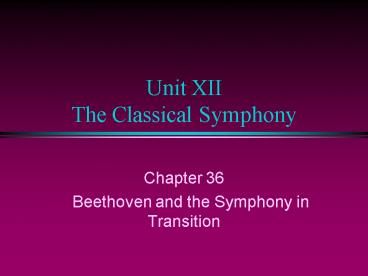Unit XII The Classical Symphony - PowerPoint PPT Presentation
1 / 16
Title:
Unit XII The Classical Symphony
Description:
Bridged the Classic and Romantic eras single-handedly and established for all ... Leaves one masterpiece rescue opera (very political), Fidelio; first called Leonora ... – PowerPoint PPT presentation
Number of Views:63
Avg rating:3.0/5.0
Title: Unit XII The Classical Symphony
1
Unit XIIThe Classical Symphony
- Chapter 36
- Beethoven and the Symphony in Transition
2
Ludwig van Beethoven
- 1770-1827
- Bridged the Classic and Romantic eras
single-handedly and established for all time the
place of the independent artist - Was championed by powerful Viennese patrons
3
Three Periods - Imitation
- Reflected the classical elements he inherited
form Haydn and Mozart
4
Three Periods - Experimentation
- More closely aligned with the characteristics of
the nineteenth century - strong dynamic contrasts
- explosive accents
5
Three Periods - Experimentation
- longer movements
- First movement -- expanded dimensions, especially
of the coda and development, which he made
dynamic center of the form. - Second movement -- hymnic character
- Third movement -- substituted the rhymically
vital scherzo for the minuet - Fourth movement -- enlarged to comparable size
and scope with the first movement
6
Three Periods - Introspection
- Rigidly pared away all nonessential elements from
his compositional techniques. - More chromatic harmonies
7
Music
- 32 Sonatas - spanning his career.
- 9 symphonies which take on the stature of
spiritual dramas. No composer since can compose
a symphony not indebted to Beethovens. - 5 piano concertos including the 5th in E flat,
the Emperor. - Many influential string quartets
8
Music
- In vocal music, Beethoven
- Establishes the song cycle in An die ferne
Geliebte - Leaves one masterpiece rescue opera (very
political), Fidelio first called Leonora - Two great masses
- An oratorio, Christ on the Mount of Olives
- The Ninth Symphony, which breaks the
predetermined symphonic mold forever.
9
Fifth Symphony in C minor, Op. 67
- Bound by the motive "Fate knocks at the door
- Listening Guide 21, pp. 202-205 (CD 2/4-28)
10
First Movement Allegro con brio
- Opening 4 note motive not only creates the
materials for the first theme group, but serves
as a rhythmic motive unifying the whole symphony - Note extremely short bridge based on theme 1
- Even Theme 2 is accompanied by the rhythmic
motive which pervades this movement
11
First Movement -- Allegro con brio
- Powerful dynamic changes and abrupt contrasts are
characteristic of Beethoven's style - Note solo oboe in Recapitulation between Theme 1
and 2! Furthermore, the second theme continues
in C major to the end!
12
Second Movement -- Andante con moto in A flat
major
- Theme and variations.
- All procedures of variation used
- melodic outline
- harmony
- rhythm
- tempo
- dynamics
- register
- key
- mode
- types of accompaniment
13
Second Movement -- Andante con moto in A flat
major
- Two related themes used, the second employing the
Fate motive.
14
Third Movement -- Scherzo in C minor
- Note use of rocket theme in this scherzo
- Trio shifts to C major -- cosmic laughter theme
- The scherzo on return is reorchestrated
- The Fate motive appears in the tympani
15
Fourth Movement -- Allegro in C Major
- The scherzo moves without interruption into this
triumphal movement in a monumental sonata form. - Exposition
- Theme I Bridge Theme II Codetta
- C Major----------------- G Major------
16
Fourth Movement -- Allegro in C Major
- Note transformed Fate theme in the Second Theme
group - Note literal return of the scherzo in this
movement and insistence of the Fate motive which
returns both of these give symphony a cyclical
form































